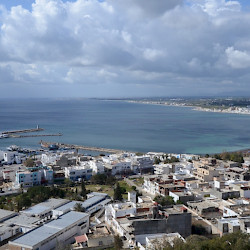Clupea
Q27241Aspis (Greek Ἀσπίς) or Clupea: fort and port on the Cape Bon peninsula.

The hill on which the fort of Aspis was built, is seventy-seven meters high and resembles a round hoplite's shield, which explains why the Greeks called it Aspis, "shield". Clupea is the Latin translation. There is an excellent harbor next to it.
At an unknown moment, a town was founded by the Phoenicians and it is likely that the hill was fortified as well. It became a stronghold of the Carthaginians later. In a late tradition, recorded by the Byzantine author Procopius, Clupea was believed to have been the place where Heracles had wrestled with Antaeus,note which may be an echo of the cult of Melqart.
Its importance was recognized by Agathocles, the tyrant of Syracuse, who invaded Africa in 310-308 and fortified this port.note During the First Punic War, the Roman consul Regulus also used Clupea as base for further operations (256-255 BCE).note In the Second Punic War, it resisted the Roman invaders, who had landed in 203;note during the Third Punic War (149-146) it held out until after the sack of Carthage.note The Romans demolished the fort.note
The port remained in use in the Roman period. During the civil wars, the army of Caesar's ally Curio used the port of Clupea; Caesar himself sailed along the shore.note The city received the rank of colonia;note an inscription mentions a magistrate named Lucius Sallustius Donatus,note and documents that the town flourished. In Late Antiquity, there were at least two Christian communities with rival bishops (mainstream and Donatist). A Christian cemetery has been identified.
The fort remained unoccupied until 580 CE, when the Byzantines built a small fort on the hill. It is a quadrangular structure, built of ancient Punic stones, with towers on the corners. A cistern is still visible. The fort surrendered to the Arab armies in 698, again after the fall of Carthage. The fort was now used as a ribat, a coastal fortification.
 Clupea, Byzantine fort |
 Clupea, Byzantine fort |
 Clupea, Byzantine fort |
 Clupea, Byzantine fort, Tower |
 Clupea, Southern harbor |
 Clupea, Byzantine fort, Courtyard |
 Clupea, Lower town |
 Clupea, Mosque |
Clupea remained an important port until the eleventh century, when it was contested by the Norman rulers of Sicily and the Zirids of Ifriqiya. The town was now abandoned and the inhabitants moved inland. The fort was reinforced by the Zirids in 1112; new walls were built, enclosing the old Byzantine fort, which still dominate the site.